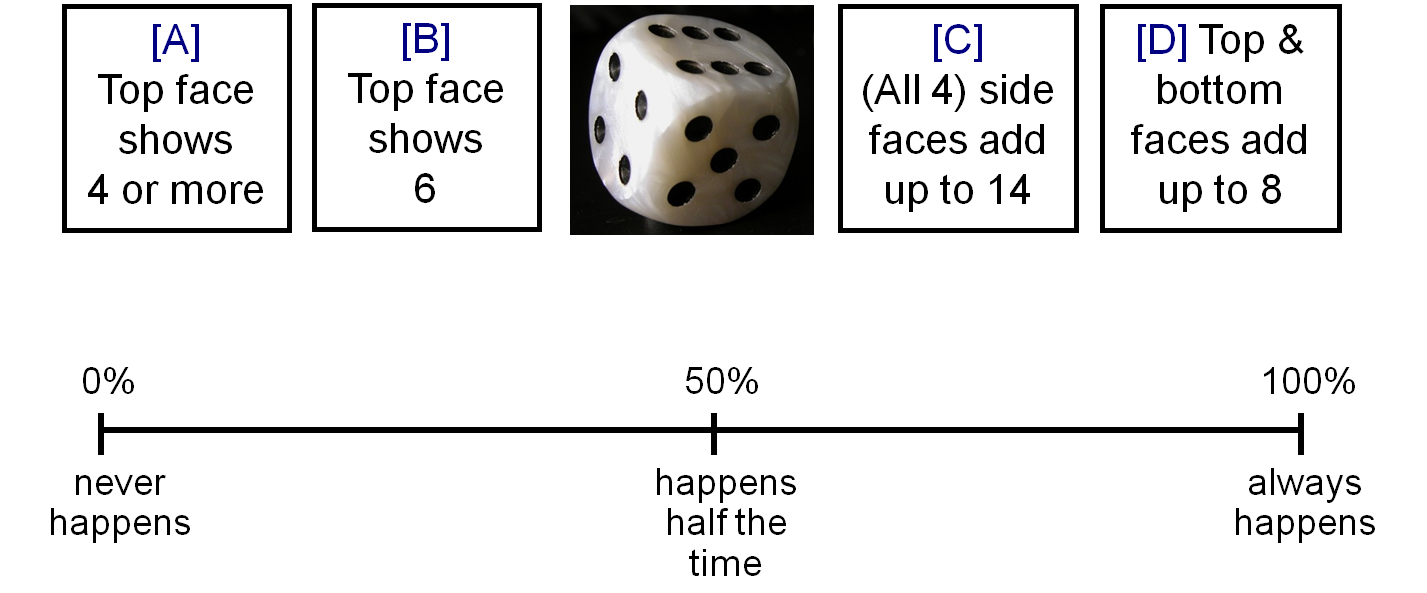Skip over navigation
One aim of this activity is to informally develop the equally-likely outcomes approach to quantifying probability. Another is to informally introduce the probability scale as a means of displaying probability values.
Below are some events that might happen when a dice is thrown. Where would you place them on the probability scale? Can you explain your reasoning?

Working in pairs, leading into whole class discussions.
Ask students to work in pairs. Emphasise that they should try to agree not just on answers but on the reasoning behind them.
If many pairs are not developing sound responses to A and B, then bring the class together to exchange ideas before resuming work in pairs.
Initiate a final whole-class discussion by choosing a suitable item and asking one pair to report what they agreed together. Ask them to back up their ideas with reasons. Then ask if any pair arrived at a different answer, or found different reasons.
Discuss further items if time permits.
[A] top face shows 4 or more and [B] top face shows 6
One line of argument on A is that scores 4, 5 or 6 represent half the (equally-likely) possibilities, balancing 1, 2 or 3, so that this event 'happens half the time'. Another line of argument on both A and B is that any score represents one of six equally-likely possibilities, and so each score has a 1 in 6 chance of occurring. If the connections between such arguments are not clear to students then they are worth discussing further. This may provide an opportunity to discuss and debug the common misuse of '50-50 chance' to refer very broadly to any uncertain result, or to any outcome for which there are other equally-likely ones.
[C] all four side faces add up to 14 and [D] top and bottom faces add up to 8
If they are unsure where to start, encourage students to make a guess, and then to test that guess against the results from several trial throws. They are likely to be surprised. The event C 'always happens', D never. Encourage students to discuss why this might be. Essentially, the result is driven by the property that a dice has three pairs of opposite faces, with each pair having a total score of 7. However the dice lands, one of these pairs occupies the top and bottom positions, and the other two pairs the side positions. An extension task is to try to change the position of numbers on a dice so that event C 'never happens' or 'happens half the time'.



Or search by topic
Number and algebra
Geometry and measure
Probability and statistics
Working mathematically
Advanced mathematics
For younger learners
What do you know about Probability? (2)
Age 11 to 14
Challenge Level 





- Problem
This activity was developed by the epiSTEMe project. More information about the project, and the other epiSTEMe activities available on NRICH, can be found here.
Rate the chance of dice events
One aim of this activity is to informally develop the equally-likely outcomes approach to quantifying probability. Another is to informally introduce the probability scale as a means of displaying probability values.
Activity
Below are some events that might happen when a dice is thrown. Where would you place them on the probability scale? Can you explain your reasoning?

Working in pairs, leading into whole class discussions.
Ask students to work in pairs. Emphasise that they should try to agree not just on answers but on the reasoning behind them.
If many pairs are not developing sound responses to A and B, then bring the class together to exchange ideas before resuming work in pairs.
Initiate a final whole-class discussion by choosing a suitable item and asking one pair to report what they agreed together. Ask them to back up their ideas with reasons. Then ask if any pair arrived at a different answer, or found different reasons.
Discuss further items if time permits.
Key Points
[A] top face shows 4 or more and [B] top face shows 6
One line of argument on A is that scores 4, 5 or 6 represent half the (equally-likely) possibilities, balancing 1, 2 or 3, so that this event 'happens half the time'. Another line of argument on both A and B is that any score represents one of six equally-likely possibilities, and so each score has a 1 in 6 chance of occurring. If the connections between such arguments are not clear to students then they are worth discussing further. This may provide an opportunity to discuss and debug the common misuse of '50-50 chance' to refer very broadly to any uncertain result, or to any outcome for which there are other equally-likely ones.
[C] all four side faces add up to 14 and [D] top and bottom faces add up to 8
If they are unsure where to start, encourage students to make a guess, and then to test that guess against the results from several trial throws. They are likely to be surprised. The event C 'always happens', D never. Encourage students to discuss why this might be. Essentially, the result is driven by the property that a dice has three pairs of opposite faces, with each pair having a total score of 7. However the dice lands, one of these pairs occupies the top and bottom positions, and the other two pairs the side positions. An extension task is to try to change the position of numbers on a dice so that event C 'never happens' or 'happens half the time'.
You may also like
What Do You Know about Probability? (1)
What is special about dice?
How can we use dice to explore probability?
Tools for Thinking about Probability
Can you design your own probability scale?
How do you describe the different parts?
A Brief History of Probability
Can you help d'Alembert discover the probabilty of at least one head in two coin flips?

